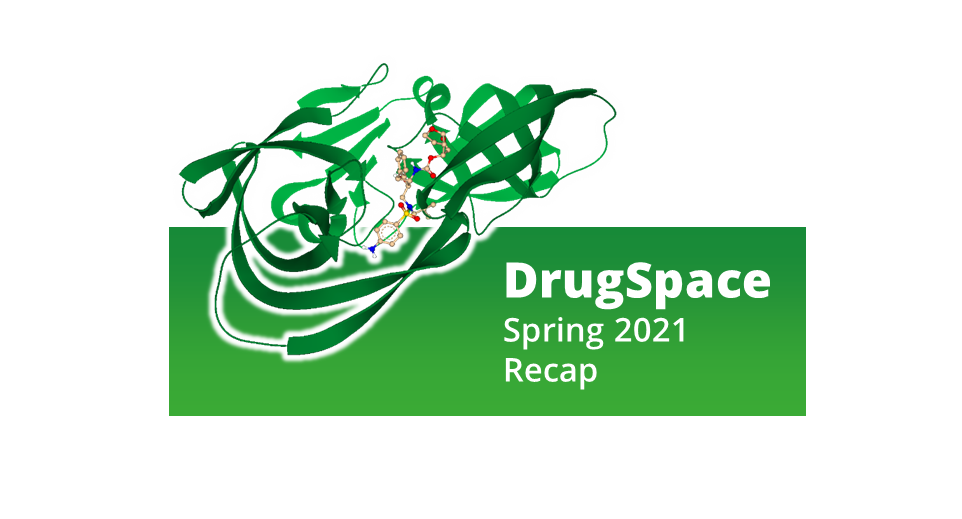A few months have passed since the DrugSpace Symposium Spring and the results and discussions are still echoing. The speakers and participants made this event a pioneering success in the field of innovative drug hunting methods and strategies for medicinal chemistry enthusiasts. Under the slogan ‘Targets, Compounds, Spaces’, speakers across the world have presented unique possibilities to maneuver through vast Chemical Spaces and colossal amounts of data.
The major message of the symposium was clear: mining from rapidly growing databases is no longer limited to scholars in their ivory towers but can pave the way to novel state-of-the-art research practice. The disclosed campaigns have shown how to be able to foster lead and drug discovery among several targets and protein classes and the interest in Chemical Space exploration increases for both academia and industry alike. Interdisciplinary collaborations between computer-aided drug design, compound vendors, and protein crystallography can cost-efficiently deliver several lead-like scaffolds within weeks. Unlocking chemical matter through in-house built Chemical Spaces led to breakthroughs for difficult targets across several independent efforts in Big Pharma. Convenient access to interesting compounds may therefore become a game changer for the whole industry in the next years.
We would like to use this opportunity to thank all the speakers and participants once again, be it either for the discussion during the symposium or during the reception in Gathertown afterwards. The first virtual BioSolveIT symposium was characterized by the organic interaction between audience, presenters and organizers that made this experience so familar to a face-to-face meeting.
In case you have missed a talk you have now the possibility to conveniently watch the recording of your favorite topic or speaker.

Barbara Zdrazil
EMBL-EBI/University of Vienna
“Trending Targets: Monitoring Targets in Drug Discovery through the Years”
Over 3,000 druggable structures exist in the human body containing frequently targetted and understudied members. Barbara discusses how we can utilize the public knowledge for informed target selection to select good candidates with high druggability. Trend analyses coupled with novel opportunies for drug intervention can help to guide decision making at the early stages of campaigns.
Yaroslav Bilokin
Otava Chemicals
“Human Protein Kinase CK2 Inhibitors: Discovering New Scaffolds”
Several scaffolds are reported to act as inhibitors of the human protein kinase CK2. Starting from a ligand-based approach, flavonoids with nanomolar inhibitory effect and drug-like propeties were designed and synthesized at Otava. Finally, Yaroslav announces the new on-demand Chemical Space CHEMriya.
Yurii Moroz
Chemspace
“Chemspace Platform: the Largest Catalog of Small Molecules to Search and Buy from!”
The largest online catalog for small drug-like compounds presents how you can search efficiently and fast for molecules of interest. Several sublibraries (e.g. fragment-like, DEL building blocks, pre-plated sets, target-oriented libraries) are available to match your needs.
Yan Xu
WuXi AppTec
“Introduction of GalaXi – The WuXi AppTec Virtual Space”
Giving an introduction to GalaXi Chemical Space, Yan shows the diversity behind WuXi AppTec methods for compound synthesis and on-going drug discovery projects. With insights on template-based virtual libraries she highlights the application of different chemo-type scaffolds including fused and rigid ring systems in the creation of GalaXi.
Matthias Rarey
Center for Bioinformatics/University of Hamburg
“Some New Algorithmic Approaches for Cheminformatics and Modeling”
Individual challenges demand for indivudal tools. In his talk Matthias outlines computational chemistry routes and methods for drug discovery and Chemical Space exploration. Furthemore, he elaborates on the strenghts and limits of topological similarity, MCS, reduced graphs, pharmacophore-based searches, and docking.
Uta Lessel
Boehringer Ingelheim
“How to Compare Ultra-Large Chemical Spaces?”
Why do we need different Chemical Spaces? In her presentation Uta provides insights how to compare spaces of different origins. Surprisingly, only a tiny fraction of molecules was found in the overlap of BI, REAL and GalaXi, highlighting the necessity of different compound providers and translation of in-house knowledge to propietary Chemical Spaces.

Marcus Gastreich
BioSolveIT
“Fuzzy and Structure-Driven Navigation in Billion-Sized Haystacks”
Chemical Spaces possess great potential but they also pose challenges to conventional methods like computation time and storage issues. Therefore, smart solutions are required and urgently needed. Marcus elaborates on the building of a Chemical Space and how conventional docking may be adapted to handle the colossal numbers.
Serghei Glinca
CrystalsFirst
“Cheaper, faster, smarter lead generation: Accelerating discovery of active compounds with protein-fragment complexes”
The drug discovery process does not have to be funnel-shaped where you start with a large amount of compounds and filter them during each step. This disruptive interdisciplinary approach is presented bei Serghei on a case-study where fragment-protein crystallography was the initiator for lead-like discovery resulting in several novel scaffolds and tremendous boosts in affinity.
Hugues Lemoine
Edelris
“Navigating in Natural Product inspired Keymical Space with EDEN”
Several reports on the advantages and potential of natural compounds have been published in the past decade. The forte of Edelris is focussed on unique chemical building blocks to synthesize nature-inspired molecules with favorable properties for lead and drug discoveries.
Debanu Das
Accelero Biostructures
“Screening Molecular Compound Libraries Directly by Protein X-ray Crystallography”
Debanu presents Accelero’s history and outlooks towards a leading company in protein crystallography-driven drug discovery that contributed to more than 1,500 entries in the PDB and over 300 publications on structures and methods development.
Zhijie Liu
Johnson & Johnson
“Construct & Explore Virtual Libraries to Support a Janssen Kinase Project”
Janssens Virtual Library (JVL) was designed to target in-house projects by drawing from propietary building blocks and synthesis protocols resulting in over 1019 compounds. Two new series of scaffolds were discovered for an ongoing kinase projects with the constructed Chemical Space.
Friedrich Rippmann
Merck KGaA
“Ultra-Large Tailor-Made Chemical Spaces”
How to tackle the declining efficiency in drug discovery over the past years? Friedrich discloses how Chemical Spaces can be a rich source for this very problem. Several hits were found from Merck’s propietary MASSIV Chemical Space for a broad range of targets with novel predictive models.





